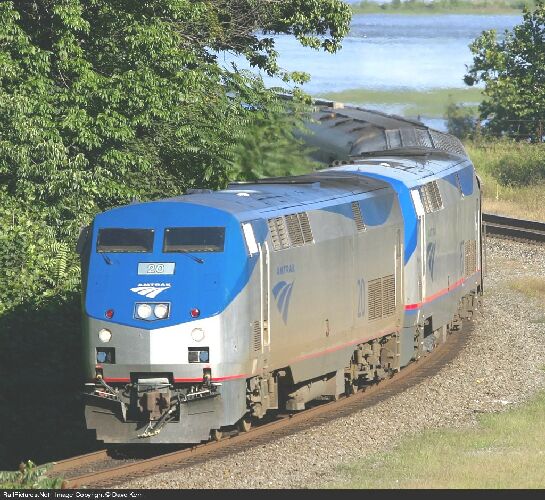
Light Rail Progress can be contacted at: Light Rail Progress |
The following analysis of the US Bush Administration's claims about Amtrak, and their proposal to eliminate funding in the 2006 budget, has been slightly edited and re-published from the original on the website
of the National Aossociation of Railroad Passengers: Claim:
President Bush's fiscal 2006 budget, page 243:
President Bush's fiscal 2006 budget, page 813: Fact:
With no Federal subsidy, Amtrak would be forced into bankruptcy and
would be controlled by a bankruptcy trustee whose statutory responsibility
is to the railroad's creditors. For more details, read Senator Patty Murray's (D-Wa) letter to Secretary of Transportation Norman Y. Mineta: Claim:
Secretary of Transportation Norman Y. Mineta (New York Times op-ed, Feb. 23): Fact: Such a partnership would be meaningless if Amtrak is forced into bankruptcy because loss of the foundation Amtrak provides (which Mineta refuses to acknowledge) would dramatically increase state costs to provide service. [Nonetheless, we strongly support such a partnership, although we would prefer an 80% federal share to put rail closer to an equal footing with highway and aviation projects.] Amtrak needs $1.2 billion for a Northeast Corridor-only operation in fiscal 2006; a mere $300 million more would permit nationwide service to continue; another $500 million (for a total of $2 billion) could provide the federal match for a state-controlled corridor development program. Claim:
Mineta (New York Times op-ed, Feb. 23): Fact: Amtrak fully funds half (two) of Amtrak's four Portland-Seattle daily round- trips as part of its national network service; the Amtrak-funded trains are Trains 11, 14, 500 and 509. Beyond that, Amtrak's disappearance would drastically increase the cost to the state of funding the two Portland- Seattle trains it currently pays for, as well as the single Seattle-Vancouver, B.C. train. Claim:
Mineta (prepared remarks, Charlotte, NC, press conference, Feb. 22): Fact: This train does not "cover its operating costs," which is why the state paid Amtrak almost one million dollars for its operation in fiscal 2004. This payment, like other state payments, covers only direct operating costs, and not the various overhead items that would become state responsibilities if Amtrak actually disappeared. Claim:
Mineta (New York Times op-ed, Feb. 23):
Mineta (Charlotte, Feb. 22):
Mineta (prepared remarks, Chicago, IL, press conference, Feb. 14): Fact: In fiscal 2004, the average number of travelers on a national network (NN; long-distance) trains at any one time (measured in passenger-miles-per- train-mile) was 170.6. That is 17% higher than on short-distance trains, where the comparable figure was 133.9. NN trains accounted for 48% of all Amtrak passenger-miles but only 42% of all Amtrak train-miles. [The previous paragraph assumes Mineta's criticism is aimed at the NN trains, since they get no state operating-grant support. However, many corridor trains around the country also get no such support. We believe any service crossing multiple state lines, including the NN trains as well as intercity trains on the Northeast Corridor, require federal leadership and support if they are to survive and prosper and thus are placed at risk by the President's budget. Even where states do provide operating support, they are funding direct operating costs only, not various overhead costs that would be thrust upon them if Amtrak actually did go bankrupt.]
Claim:
Mineta (New York Times op-ed, Feb. 23): Fact: Most tracks Amtrak uses are owned by private freight railroads. The Association of American Railroads' Amtrak reform principles include this: "Safety and the integrating nature of railroading require that intercity passenger rail be provided by one entity – Amtrak. Further, Amtrak's right of access, preferential access rates, and operating priority should not be transferred or franchised." Speculation: in this matter, the railroads almost certainly would beat back any attempt to change federal law in a way that they regard as hostile. Light Rail Now! website Updated 2005/02/26 |
|
|
|